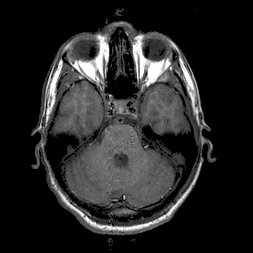

 You are learning to understand the language of music, and there are
some basic things you have to memorize for quick recall in order to
recognize the larger forms. Fortunately there
aren't too many--it's a lot easier than chemistry.
You are learning to understand the language of music, and there are
some basic things you have to memorize for quick recall in order to
recognize the larger forms. Fortunately there
aren't too many--it's a lot easier than chemistry.
Learn the number of beats indicated by the various types of notes (whole, half, quarter, eighth, sixteenth), and the modifications created by adding dots and ties. Learn to tap the rhythm of notes in musical scores while counting the beats (i.e. "one and two and three and four and").
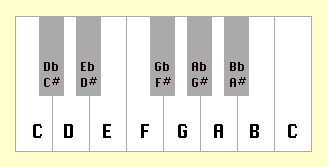 Learn the pitches of the treble and bass clefs.
Know what the letter name is for each note (maximum one second per note) and
where each is located on the piano keyboard (two seconds per note). If
you're working at the piano, try singing the letter name using the right
pitch--check yourself by playing the note on the piano.
Learn the pitches of the treble and bass clefs.
Know what the letter name is for each note (maximum one second per note) and
where each is located on the piano keyboard (two seconds per note). If
you're working at the piano, try singing the letter name using the right
pitch--check yourself by playing the note on the piano.
Know order of intervals in order to construct a major scale (whole, whole, half, whole, whole, whole, half ). The first five notes have the interval pattern whole, whole, half, whole), so the sisters and brothers of the secret society who are traveling or have traveled this road before identify themselves with the hand sign:
The reason the third and fourth fingers of the right hand are squeezed together is because that is where the half step lies when you play the first five notes of the major scale on the piano. Using this knowledge you should be able to play the first five notes of any scale by placing your right thumb on any note, then going up a whole step, then another whole step, then a half step (the third and fourth fingers are close together in the secret hand sign for this reason), and then one more whole step. Say the names of the notes as you go up the five notes.
Be able to say the pitches of any major scale. Be able to play any major scale on the piano. To do this it will help if you know the key signatures as arranged on the Circle of Fifths (see below). As you study the Circle, say the number of accidentals and what they are ("Bb major, 2 flats: Bb and Eb"). Then say the names of the notes of the scale: "Bb, C, D, Eb, F, G, A, Bb."
You can use our flashcards for the notes of treble and bass clefs and key signatures.
The elegance of the Circle is that it arranges the key signatures in a logical order. As you go around clockwise you either add a sharp or take away a flat from the key signature. There is overlap at the bottom showing common enharmonic equivalents. There are 12 positions like the hours on a clock. I suggest you copy the Circle over and over using the spokes I've drawn in to help with the spacing.

|
Going around the circle of fifths clockwise the key signatures, starting from "C" (no sharps or flats) at the top add a new sharp each time. For example, "C" has no sharps. The notes of the C major scale are C, D, E, F, G, A, B, C. The key of G major (at "one o'clock" or one stop clockwise from "C") has one sharp, F#. This means that as you go through the letter names starting with "G": G, A, B, C, D, E, F, G, that the "F" will be sharped, so the the G major scale is spelled G, A, B, C, D, E, F#, G. The next key clockwise is D major. It has two sharps, the same F# that G major had, along with a new sharp, C#. There is always a new sharp as you go around clockwise, and they are added in the order F#, C#, G#, D#, A#, E#, B#. There is a memory aid with the letters of the sharps arranged in a sentence:
|
Fat Cats Get Dizzy After Eating Beef or Fat Cats Go Down Alleys Eating Birds |
If you know a key signature has 3 sharps (that is, A major), then the three sharps will be F, C, and G, the first letters in the first three words of the phrase "Fat Cats Get", and you will see those three sharps in the key signature for A major below.
The going around the Circle counter-clockwise starting at the top from C major adds a new flat for each key. F major has one flat (Bb), Bb major has two flats (Bb and Eb). The flats get added in the order that's just the reverse of the order of the sharps: B-E-A-D-G-C-F. One way to remember that is with the phrase
|
Big Elephants Always Deserve Good Circus Food |
(actually they deserve much better)
Help yourself to my online drill--you'll need to be using Microsoft Internet Explorer (Netscape won't work). Another way to do it, and something fun to do while waiting for something to happen, is to use your right hand for sharp keys and your left for flat keys.
 Hold up your right fist and say "C major"--with no
fingers raised this means no sharps.
Hold up your right fist and say "C major"--with no
fingers raised this means no sharps.
 Then extend up your index finger and
say "G major". Once you can go back and forth between C and G
major you can add a third key: D major.
Then extend up your index finger and
say "G major". Once you can go back and forth between C and G
major you can add a third key: D major.
 Hold up your index and middle
finger (meaning 2 sharps) and say "D major". Go back and forth
randomly for a while until you can do C, G, and D very quickly. Don't go
on until you are very good at these three.
Hold up your index and middle
finger (meaning 2 sharps) and say "D major". Go back and forth
randomly for a while until you can do C, G, and D very quickly. Don't go
on until you are very good at these three.
 Then you can hold up three
fingers for "A major", and so on. An extension of this is to add
the names of the sharps after each key, for example, (holding up three fingers)
say: "A major: F#, C#, and G#."
Then you can hold up three
fingers for "A major", and so on. An extension of this is to add
the names of the sharps after each key, for example, (holding up three fingers)
say: "A major: F#, C#, and G#."
 "E major: F#, C#,
G#, and D#".
"E major: F#, C#,
G#, and D#".
 When you get to B major you
open up with your thumb. "B major: F# C#, G#,
D#, A#"
When you get to B major you
open up with your thumb. "B major: F# C#, G#,
D#, A#"

 When you get to
F# major you'll need to
borrow a finger from the left hand to indicate 6 sharps. "F major: F#,
C#, G#, D#, A#, E#".
When you get to
F# major you'll need to
borrow a finger from the left hand to indicate 6 sharps. "F major: F#,
C#, G#, D#, A#, E#".

 "C#
major: F#, C#, G#, D#, A#,
E#, B#"
"C#
major: F#, C#, G#, D#, A#,
E#, B#"
You go through the flats in the same way, using your left hand:
 Left
fist closed means C major (no flats).
Left
fist closed means C major (no flats).
 Index finger up is F major.
"F major: Bb".
Index finger up is F major.
"F major: Bb".
 Index and middle fingers are Bb
major. "Bb major, Bb and Eb", and so on. Do a few keys at a
time. You can do this kind of exercise in a couple of minutes, as you're
walking around, waiting on hold on the telephone, for someone to get ready to go
somewhere, whenever you have a couple of minutes to set free.
Index and middle fingers are Bb
major. "Bb major, Bb and Eb", and so on. Do a few keys at a
time. You can do this kind of exercise in a couple of minutes, as you're
walking around, waiting on hold on the telephone, for someone to get ready to go
somewhere, whenever you have a couple of minutes to set free.
 "Eb: Bb, Eb,
and Ab"
"Eb: Bb, Eb,
and Ab"
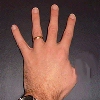 "Ab major: Bb, Eb,
Ab, Db"
"Ab major: Bb, Eb,
Ab, Db"
 "Db major: Bb, Eb,
Ab, Db, Gb"
"Db major: Bb, Eb,
Ab, Db, Gb"

 "Gb
major: Bb, Eb, Ab, Db, Gb,
Cb"
"Gb
major: Bb, Eb, Ab, Db, Gb,
Cb"


Don't try to learn all the keys in one day. Pick three keys at a time to drill on, don't move on until you're really fast at all three. The most efficient way to learn is to review the material just before you would have forgotten it. The trick is to know when you're just about to forget something so you can refresh it. Since you don't know, just don't wait too long. Do this a few times a day for a few minutes. If you do three new keys a day and review the ones you've learned before, within a week you'll know all your key signatures and scales fast. This will be of tremendous value in your theory studies, since you'll be able to access the information quickly. Warning: If you continue this process reinforcing the knowledge for a month or so it will enter your longterm memory and you'll never (be able to) forget it!
Once you can do this working around the Circle of Fifths clockwise and counterclockwise, jump around randomly among the sharps and flats and see if you can remember how many flats/sharps/fingers to hold up.
Why do we move our fingers and say the words aloud? Moving your muscles and hearing the words helps get it into your brain faster.
Another useful variation of the exercise is to add on to the end of each key saying aloud the notes of the scale. Start out on the letter of the alphabet for the note and run through from wherever you are through the other six letters, starting over with "A" after you reach "G".
"A - B - C - D - E - F - G - A" (if your scale starts on the letter "A")
or
"B - C - D - E - F - G - A - B" (if your scale starts on the letter "B")
or
"C - D - E - F - G - A - B - C" (if your scale starts on the letter "C")
or
"D - E - F - G - A - B - C - D" (if your scale starts on the letter "D")
Continue this exercise starting on "E", "F", and "G".
It's a good idea to do this exercise until you are quickly able to run through the alphabet starting on any of letter. If you can't, it will be harder to add "flat" and "sharp" to the letters corresponding to the different key signatures. Once you know the order of the letters well you can repeat the process, but this time add "flat" or "sharp" after the letters you are naming off, corresponding to the flats or sharps you have just listed, represented by the fingers you are holding up.
For example, once it is easy to say quickly "B - C - D - E - F - G - A - B", you can add the two flats for Bb major:
 "Bb major (name
of key): Bb, Eb.(key signature), Bb - C - D - Eb
- F - G - A - Bb (notes of scale)."
"Bb major (name
of key): Bb, Eb.(key signature), Bb - C - D - Eb
- F - G - A - Bb (notes of scale)."
The same sequence "B - C - D - E - F - G - A - B" is used for B major as well:
 "B
major (name
of key): F# C#, G#,
D#, A# (key signature), B -
C# - D# - E - F#
- G# - A# - B"
"B
major (name
of key): F# C#, G#,
D#, A# (key signature), B -
C# - D# - E - F#
- G# - A# - B"
Test yourself using my web page (must use Microsoft Internet Explorer, not Netscape).
Once you know what the components of the key signatures are you are ready to learn how to correctly write key signatures.
Leaving out Cb and C# for now, here are the key signatures written on the treble and bass clefs
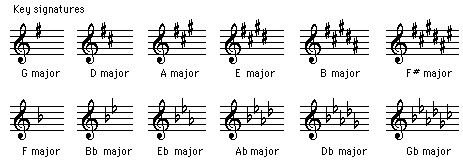
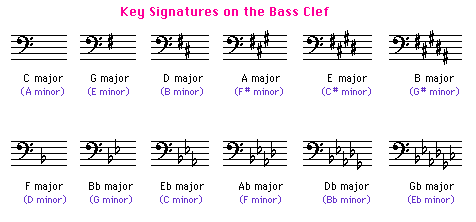
The relative loudness of music is indicated using letter abbreviations of Italian terms. "p" stands for "piano", or "soft". "issimo" means as much as possible, so "pianissimo" is as soft as possible, and is abbreviated "pp". "f" stands for "forte", or loud. "m" stands for "mezzo", or medium. "m" can be combined with "f" or "p" to make them less extreme. I don't know how you can get softer than that, but since in modern times everything gets bigger and smaller, there are now "ppp" (softer than as soft as possible), and "fff" (louder than as loud as possible).
Dynamics are relative and depend on the artist, venue, distance to audience, and what else is going on at the time (i.e. other instruments). When one plays at fancy receptions all dynamics should be shifted one or two towards the quiet end of the spectrum.
Here is an explanation of the current conception of dynamics in English:

©2001 Robert Willey